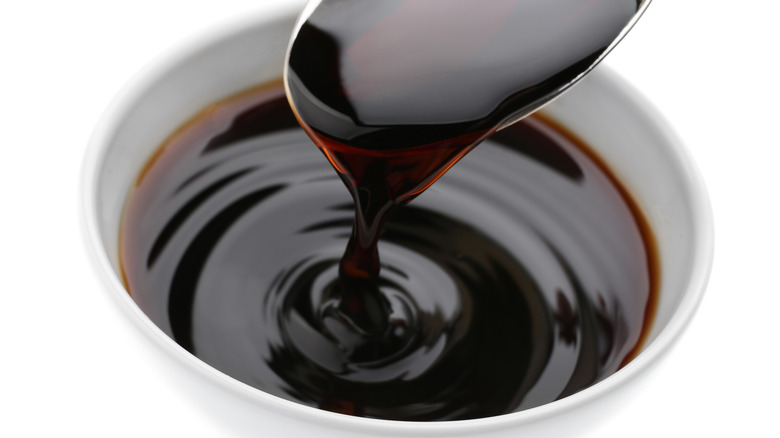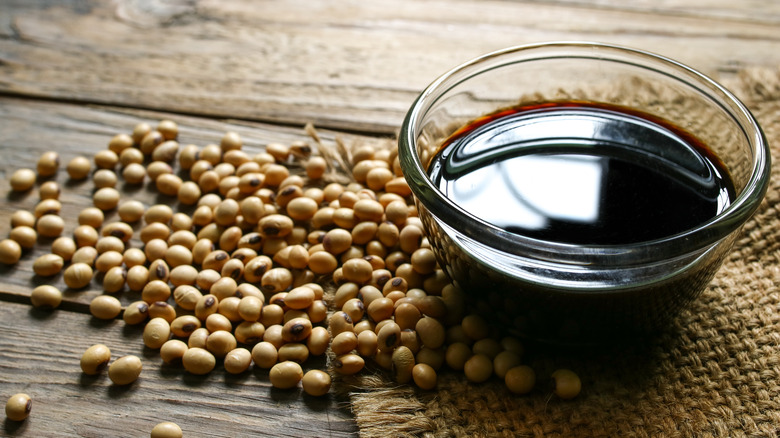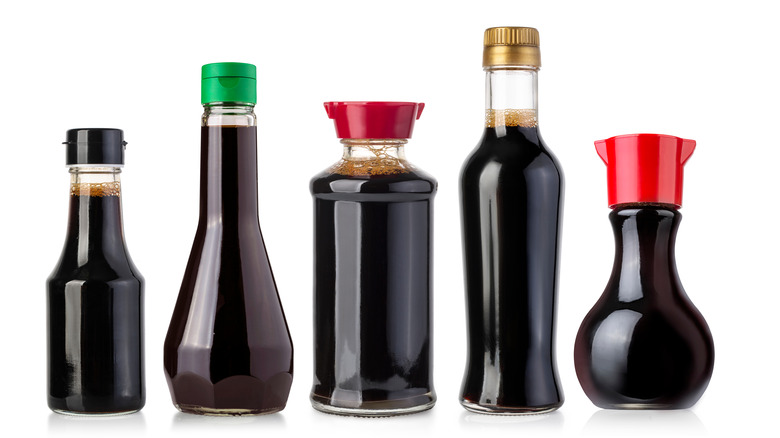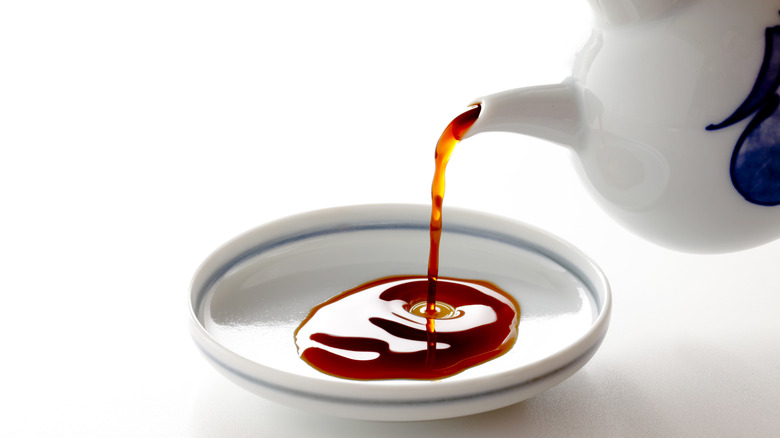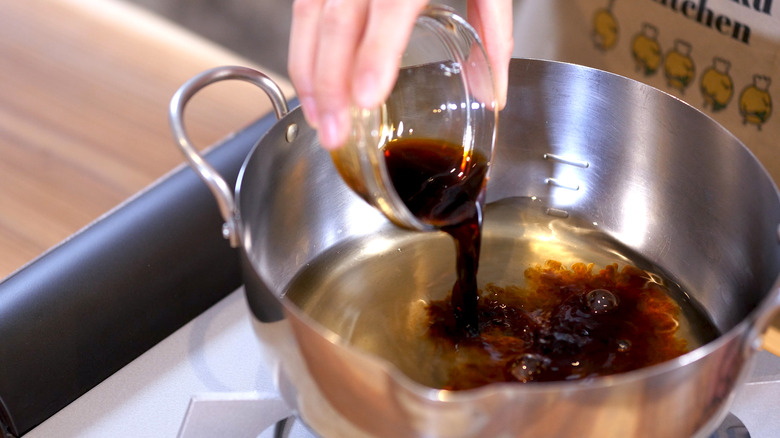Everything You Need To Know About Soy Sauce
When it comes to America's favorite condiments, soy sauce ranks right up there with everyday picnic-table favorites. A reader survey conducted by The Daily Meal lists soy sauce as America's fourth-favorite condiment after mayonnaise (No. 1), mustard (No. 2), and ketchup (No. 3). Cast the net a bit wider and soy sauce still makes an impressive showing, ranking No. 8 on HuffPost's list of the world's 25 best condiments.
Science Meets Food traces the origins of soy sauce to fifth-century B.C. China where it was developed as an alternative to more expensive salt. The process of making soy sauce was an arduous task. According to the SoyInfo Center, original incarnations involved mixing cooked soybeans with wheat flour and salt water, then letting the mixture ferment in clay pots for three to six months. When it was deemed ready, liquid was separated from the fermented mash and set out to age for another month or two. The process was repeated up to four times resulting in various grades of the final product. By the third century B.C., Buddhist monks were using the fermented sauce as the primary seasoning in their vegetarian diets. Eventually, according to Science Meets Food, Japanese Buddhist monks who had been studying in China returned home with the condiment where its variant, shoyu, emerged. Production tweaks continued, culminating in the third century with a recipe widely believed to be the basis of the Japanese soy sauces prevalent worldwide today.
What is soy sauce?
No matter how it's blended, soy sauce contains just five ingredients: water, soybeans, wheat, salt, and koji (an ancient mold that flourishes in a hot, humid environment, according to Cooks Illustrated). Those simple ingredients beget different flavors and colors from light to dark and bitter to sweeter. The ratio of soy to wheat produces marked differences, according to Science Meets Food. The most common blend, koikuchi, features equal portions of wheat and soybeans. Usukuchi tastes a lot like koikuchi but has a lighter color achieved by adding wheat gluten or fermented rice (via Umami Insider). Tamari is a gluten-free alternative, made without wheat. Shiro contains more wheat than soy and saishikomi is a double-brewed, more robust, version of koikuchi.
While the process of producing soy sauce has evolved over centuries, The Kikkoman Soy Sauce Museum says modern automated production at its facilities still follows the traditional brewing method called honjozo, relying on koji to jumpstart natural fermentation.
Varieties of soy sauce
Once upon a time, way back in the 20th century, selecting soy sauce at a local grocery store was a simple process. The prevailing variety was what we now know as koikuchi. The choice boiled down to a few brands, not flavors. Peruse the Asian foods aisle at a mainstream supermarket today and the options are seemingly endless. Serious Eats breaks it down. In addition to Japanese-style all-purpose koikuchi, you'll likely find lighter, richer, and slightly sweet usukuchi. Koikuchi and usukuchi are interchangeable in most recipes, but taste test to be sure you're not overdoing it with the richer blend. Tamari, made without wheat, is the best choice for gluten-free diets. Shiro, also known as white soy sauce, is blended with a higher percentage of wheat resulting in a lighter color and flavor.
According to The Woks of Life, Chinese soy sauce is saltier than its Japanese counterpart. Available in both light and dark blends, Sous Chef describes the light version as strong and pungent with notes of beans, while the dark blend is intense with a forward sour bitterness and strong umami flavor. Top brands of Chinese soy sauce include Koon Chun, Pearl River Bridge, and Lee Kum Lee (via Mala Foods).
Is soy sauce a healthy choice?
Guidelines from The Centers for Disease Control and Prevention suggest adults consume no more than 2,300 mg of sodium per day. According to VeryWellFit, a tablespoon of soy sauce contains 879 mg of sodium. Do the math: One tablespoon of soy sauce eats up more than one-third the daily recommended maximum of sodium. Here's a jaw-dropper. Consuming too much soy sauce can be deadly. In 2011, a Virginia student downed a quart of soy sauce on dare and barely survived. As reported by NPR, the 19-year-old male's blood sodium was the highest ever recorded in an adult who survived without long-term neurological damage.
But that's extreme. Most of us wouldn't dream of ingesting more than a few drops at a time. For comparison, an average take-out packet contains about 2 teaspoons (via EverythingWhat). Even in moderation, though, the high levels of sodium contained in soy sauce can adversely affect your health. Doctor NDTV lists increased risk of breast cancer related to the isoflavones in soy, thyroid issues due to goitrogens in fermented soy sauce, and risk of cardiovascular disease among the potential problems associated with consuming soy sauce. Low-sodium soy sauce is a readily available option. Kikkoman's version contains 40 percent less salt than its regular soy sauce.
On the flip-side, soy sauce is keto-friendly (via Healthline) and there's limited evidence showing soy sauce may have some antioxidant properties (via VeryWellFit). On the horizon? The Spruce Eats reports initial research indicates the shoyu polysaccharides in soy sauce may help seasonal allergic rhinitis. As with all good things, the most prudent advice may be to enjoy soy sauce in moderation.
Cooking with soy sauce
The Food Network names soy sauce as one of the most important ingredients in Asian cooking. A staple in marinades and braises, according to The Spruce Eats, it stands up well in recipes requiring high heat, like stir-fries. In a pinch, substitute Worcestershire sauce, beef stock, beef bouillon, or even balsamic vinegar — and be sure to taste and adjust to capture the right balance of sweet and salty. Reduced-sodium blends of soy sauce are readily available in grocery stores, or try The Spruce Eats' make-it-yourself version using low-sodium beef broth, molasses, balsamic vinegar, red wine vinegar, sesame oil, garlic powder, and black pepper.
EatByDate says soy sauce usually retains its flavor and is good to use long after its official sell-by date. Store it in an airtight container in a cool, dark place with a consistent temperature — on a shelf or in the refrigerator. Ready to cook? Epicurious suggests a selection of recipes including Killer Chocolate Cake (what?) and Soy-Basted Chicken Kebabs with Sesame-Citrus Sprinkle.
